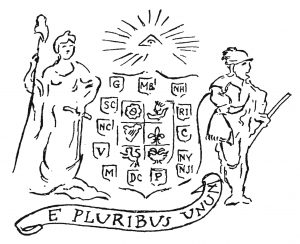Archive for July, 2016
» posted on Sunday, July 31st, 2016 by Linda Lou Burton
E Pluribus Unum
 Linda Burton posting from Arkadelphia, Arkansas – Got a US Passport? Look at the front of it. Got a one-dollar bill? Look at the back of it. Fish a dime out of your change bowl and look on the backside of that too. Look for this Latin phrase: E Pluribus Unum. Sometimes you’ll find the words embedded in the banner of the Great Seal, sometimes, due to available space I suppose, just printed straight across or curved around the edges. Do you know the meaning of these words? And how this phrase came to be an everyday, ordinary part of the American scene? First, let’s translate: E Pluribus Unum, in English form, means “out of many, one.” When Ben Franklin and Thomas Jefferson and John Adams got together back in 1776 to create an official seal for a brand-new country, they settled on the obvious basics for the design: different people from different places, now together. Their initial sketch had a shield in the middle, composed of many smaller shields; look closely to see six symbols – a rose (England), thistle (Scotland), harp (Ireland), fleur-de-lis (France), lion (Holland), and eagle (Germany), which they described as “the countries from which these states have been peopled.” Now look around the edges of the shield to see the initials of the “thirteen independent states of America.”
Linda Burton posting from Arkadelphia, Arkansas – Got a US Passport? Look at the front of it. Got a one-dollar bill? Look at the back of it. Fish a dime out of your change bowl and look on the backside of that too. Look for this Latin phrase: E Pluribus Unum. Sometimes you’ll find the words embedded in the banner of the Great Seal, sometimes, due to available space I suppose, just printed straight across or curved around the edges. Do you know the meaning of these words? And how this phrase came to be an everyday, ordinary part of the American scene? First, let’s translate: E Pluribus Unum, in English form, means “out of many, one.” When Ben Franklin and Thomas Jefferson and John Adams got together back in 1776 to create an official seal for a brand-new country, they settled on the obvious basics for the design: different people from different places, now together. Their initial sketch had a shield in the middle, composed of many smaller shields; look closely to see six symbols – a rose (England), thistle (Scotland), harp (Ireland), fleur-de-lis (France), lion (Holland), and eagle (Germany), which they described as “the countries from which these states have been peopled.” Now look around the edges of the shield to see the initials of the “thirteen independent states of America.”
 They submitted their idea to Congress on August 20, 1776, but it was not approved; in true group-think fashion it took several more committees before a final design was approved in
They submitted their idea to Congress on August 20, 1776, but it was not approved; in true group-think fashion it took several more committees before a final design was approved in
1782, one with the now-familiar American eagle in the center; the eagle carries a banner in its beak bearing that original phrase, E Pluribus Unum. You’ll notice a lot of thirteens on the seal – 13 stars, 13 stripes, 13 arrows in the eagle’s talon. And did you catch – there are 13 letters in E Pluribus Unum! I doubt Ben and Thom and John were thinking about that when they suggested the phrase; it seems to have been a recurring theme from the time of classic writers and organized systems of government. » read more
